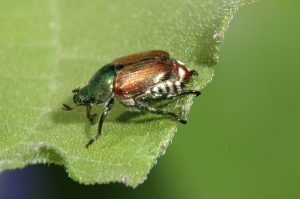Identifying and controlling Japanese Beetles in the home garden
Published on August 5, 2024 at 12:44pm CDT
Growing Green
By Robin Trott, Extension Educator


Japanese beetles, about ½ inch long and metallic green with coppery-brown wings, are infesting Alexandria this summer. These pests were accidentally introduced toNew Jersey in 1916 with nursery stock for the World’s Fair and have since spread across the United States. They first appeared in Minnesota in small numbers in 1968, but by 2001, their
population had significantly increased. Japanese beetles damage flowers, trees, shrubs, fruits, vegetables, field crops and turf. While adults feed on over 300 plant species, the grubs mainly feed on grass roots.
Adult Japanese Beetle Damage
Adult Japanese beetles feed on leaves, flowers, and fruits of many plants, including roses, grapes, lindens, apples, cherries, plums, birches, elms, raspberries, currants, basil, Virginia creeper, hollyhocks, marigolds, corn silks and soybeans. They skeletonize leaves by eating tissue between the veins, giving the leaves a lace-like appearance. Damaged leaves turn brown and may fall off.
The good news is that adult beetle damage is mostly cosmetic!
• Healthy, mature trees and shrubs can withstand heavy feeding without significant long-term harm.
• Young or unhealthy plants may be stunted, injured or killed by severe feeding.
• Healthy flowering plants, like roses, can survive, but blossoms are often ruined.
• Fruits, vegetables and herbs can tolerate some leaf damage, but severe feeding can affect growth and reduce yield.
• Regular harvesting in July and August can reduce feeding on edible parts.
Japanese Beetle Grub Damage
Grubs chew grass roots, hindering the grass’s ability to absorb water and nutrients, leading to dead patches that can be rolled back like a carpet due to the lack of roots.
Control Strategies
Controlling Japanese beetles can be either preventive or curative. Preventive control, targeting young larvae before they cause damage, is usually the most effective. Curative controls are used once damage occurs. Visit https://extension.umn.edu/yard-and-garden-insects/japanese-beetles for control strategies and to learn more about this voracious garden visitor.
Until next time, happy gardening!
* * * * * * * * * * * * * *
“The glory of gardening: hands in the dirt, head in the sun, heart with nature. To nurture a garden is to feed not just the body, but the soul.” ~Alfred Austin




